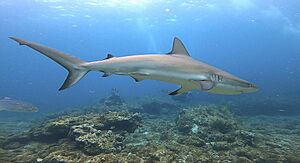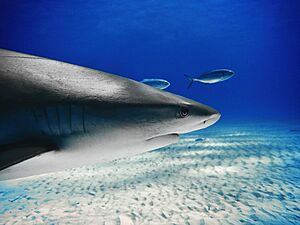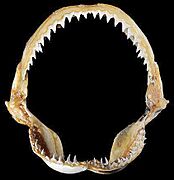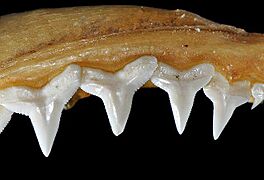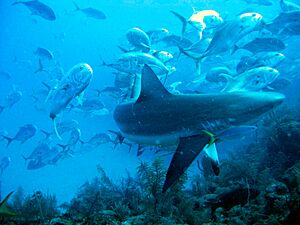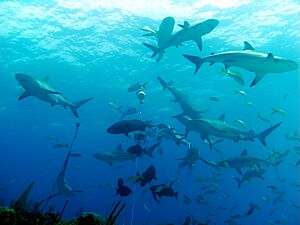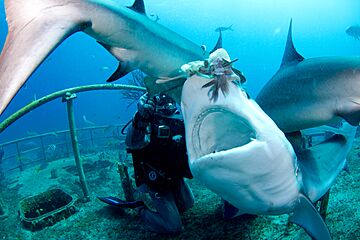Caribbean reef shark facts for kids
Quick facts for kids Caribbean reef shark |
|
|---|---|
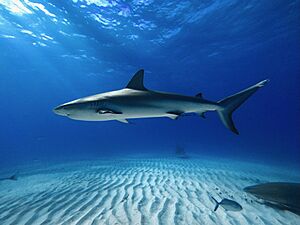 |
|
| Conservation status | |
| Scientific classification | |
| Genus: |
Carcharhinus
|
| Species: |
perezi
|
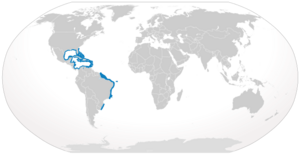 |
|
| Range of the Caribbean reef shark | |
| Synonyms | |
|
Eulamia springeri Bigelow & Schroeder, 1944 |
|
The Caribbean reef shark (Carcharhinus perezi) is a type of requiem shark. It belongs to the family called Carcharhinidae. You can find this shark in the warm waters of the western Atlantic Ocean. Its range goes from Florida all the way to Brazil. It is the most common reef shark found in the Caribbean Sea.
This shark has a strong, sleek body, much like other requiem sharks. It can be hard to tell apart from other large sharks in its family. These include the dusky shark (C. obscurus) and the silky shark (C. falciformis). Some clues to identify it are its dark fins without clear markings. It also has a short tip on its second dorsal fin, and special tooth shapes.
The Caribbean reef shark can grow up to 3 m (9.8 ft) long. It is one of the biggest apex predators in the coral reef ecosystem. It eats many kinds of fish and cephalopods like squid. These sharks have been seen resting still on the seafloor or inside caves. This is unusual for a shark that usually swims all the time. If it feels threatened, it might do a special threat display. During this display, it changes direction often and dips its pectoral fins. Like other requiem sharks, it gives birth to live young. Females usually have 4 to 6 pups every two years.
Caribbean reef sharks are important for fishing. People use them for meat, leather, liver oil, and fishmeal. But lately, they have become even more valuable for ecotourism. In the Bahamas and other places, bait is used to attract them for divers to see. This is called "shark feeding." This species has been involved in a small number of incidents with humans. These usually happen in spring and summer.
Contents
About the Caribbean Reef Shark
How it got its name
The Caribbean reef shark was first described by a scientist named Felipe Poey in 1876. He called it Platypodon perezi. He studied six sharks caught near Cuba. Later, scientists decided that Platypodon was the same as Carcharhinus. So, the shark's full scientific name became Carcharhinus perezi.
Where it lives
The Caribbean reef shark lives in the tropical western Atlantic Ocean. You can find it from North Carolina in the north to Brazil in the south. This includes places like Bermuda, the northern Gulf of Mexico, and the Caribbean Sea. It is very rare north of the Florida Keys.
These sharks prefer shallow waters around coral reefs. They are often found near the edges where the reef drops off into deeper water. They are most common in water shallower than 30 m (98 ft). However, they have been seen diving as deep as 378 m (1,240 ft).
What it looks like
The Caribbean reef shark has a strong body and a sleek shape. It looks very similar to other large requiem shark species. It usually measures 2–2.5 m (6.6–8.2 ft) long. The longest one ever recorded was 3 m (9.8 ft). The heaviest reported weight was 70 kg (150 lb).
Its back is dark gray or gray-brown, and its belly is white or yellowish. It has a faint white band on its sides. Its fins do not have clear markings. The undersides of its paired fins, its anal fin, and the lower part of its caudal fin are dark.
The shark has a short, wide, and rounded snout. Its eyes are large and round, with special protective eyelids called nictitating membranes. It has 11 to 13 rows of teeth on each side of both jaws. The teeth have wide bases and jagged edges. The front teeth are straight, while others are angled. It has five pairs of gill slits, which are moderately long.
Its first dorsal fin is tall and shaped like a sickle. It has a low ridge between its two dorsal fins. The second dorsal fin is fairly large. Its pectoral fins are long and narrow, ending in a point. The shark's skin is covered in tiny, overlapping scales called dermal denticles. Each denticle has five (or sometimes seven) low ridges.
Life and Habits
Even though there are many Caribbean reef sharks in some areas, scientists don't know a lot about them. They are thought to be very important for the health of Caribbean coral reefs. These sharks are more active at night. They do not seem to change their activity or migrate with the seasons. Young sharks tend to stay in one area, while adult sharks travel more widely.
Caribbean reef sharks are sometimes seen resting still on the seafloor or inside caves. This was the first time scientists saw an active shark species doing this. In 1975, a scientist named Eugenie Clark studied the famous "sleeping sharks" in caves near Isla Mujeres. She found that the sharks were not truly asleep because their eyes would follow divers. Clark thought that fresh water coming up in the caves might help remove parasites from the sharks.
If they feel threatened, Caribbean reef sharks sometimes perform a threat display. They swim in short, jerky movements, changing direction often. They also briefly drop their pectoral fins. This display is not as strong as the one seen in the grey reef shark (C. amblyrhynchos).
Young Caribbean reef sharks can be eaten by larger sharks. These include the tiger shark (Galeocerdo cuvier) and the bull shark (C. leucas). Not many parasites are known for this shark. One type is a dark leech that is sometimes seen hanging from its first dorsal fin. Off northern Brazil, young sharks visit "cleaning stations." Here, yellownose gobies (Elacatinus randalli) clean parasites off the sharks while they lie still. Horse-eye jacks (Caranx latus) and bar jacks (Carangoides ruber) often swim in groups around Caribbean reef sharks.
What they eat
The Caribbean reef shark eats many different kinds of fish that live on reefs. It also eats cephalopods, like squid and octopus. Sometimes, it eats other elasmobranchs, such as eagle rays (Aetobatus narinari) and yellow stingrays (Urobatis jamaicensis). It is attracted to low-frequency sounds, which often mean a fish is struggling.
Once, a 2 m (6.6 ft) male Caribbean reef shark was seen hunting a yellowtail snapper (Lutjanus crysurus). The shark slowly circled and made a few half-hearted moves toward its prey. Then, it suddenly sped up and swung its head sideways to catch the snapper. Young sharks eat small fish, shrimp, and crabs. Caribbean reef sharks can push their stomachs out of their mouths. This probably helps them clean out things they can't digest, parasites, and mucus.
How they have babies
Caribbean reef sharks give birth to live young. This is called viviparous reproduction. When the baby sharks are growing inside their mother, they first use a yolk sac for food. After that, the yolk sac turns into a placenta. This connects them to their mother, who provides them with food.
Mating seems to be a rough process. Female sharks are often found with bite marks and wounds on their sides. In some places, like the Fernando de Noronha Archipelago off Brazil, babies are born from February to April. In other places, females give birth in November and December. A female usually has 4 to 6 pups at a time. The babies grow inside her for about one year. Females become pregnant every other year. Newborn sharks are about 74 cm (29 in) long. Males are ready to mate when they are 1.5–1.7 m (59–67 in) long. Females are ready when they are 2–3 m (79–118 in) long.
Sharks and Humans
Caribbean reef sharks are usually shy or don't pay attention to divers. However, they can become more active if food is around. Since they grow quite large, they are considered potentially dangerous. As of 2008, there have been 27 reported incidents involving this species. Four of these were unprovoked, and none were fatal. However, a fatal incident in 2020 on the island of St. Martin/St. Maarten was linked to this species.
People catch this shark for commercial and local fishing throughout its range. They use longlines and gillnets. The shark is valued for its meat, leather, liver oil, and fishmeal. In Colombia, the Caribbean reef shark is the most common shark caught. Its fins, oil, and jaws (sold for decorations) are all used. In Belize, these sharks are mostly caught by accident when people are fishing for groupers and snappers. The fins are sold to the valuable Asian market. The meat is sold in Belize, Mexico, and Guatemala to make a food called "panades." A special shark fishery operated in Belize for many years. But catches of all shark species dropped sharply by the early 1990s. The meat of this shark can contain high levels of methylmercury and other heavy metals.
Shark feeding tourism
A profitable tourism business has grown around this shark. It involves organized "shark feeds." Here, groups of reef sharks are attracted to divers using bait. In the Bahamas, about US$6,000,000 is spent each year on shark viewing. At some places, a single living Caribbean reef shark is worth between US$13,000 and US$40,000. This is much more than the US$50 to US$60 it would be worth if caught and sold.
This practice has caused some debate. Some people worry that sharks might learn to connect humans with food. This could increase the chance of a shark incident. They also worry that taking reef fish for bait might harm the local ecosystem. On the other hand, supporters say that shark feeds help conservation. They give people a reason to protect sharks and teach them about these animals. So far, there is little proof that shark feeds have increased the risk of incidents in the surrounding area. Shark feeding is not allowed off the coast of Florida, but it continues in other parts of the Caribbean.
Protecting the sharks
The International Union for Conservation of Nature (IUCN) has listed the Caribbean reef shark as Endangered. Its numbers have gone down off Belize and Cuba because of too much fishing. Fishing continues in other areas as well. These sharks are also threatened by the damage and destruction of their coral reef homes.
Commercial fishing for this species is not allowed in United States waters. They are protected in the Bahamas because they are so important for tourism. They are also protected in several Marine Protected Areas (MPAs) off Brazil and other places. However, it can be hard to stop illegal fishing in some of these protected areas. Also, many places where this shark is common are not protected.
|



